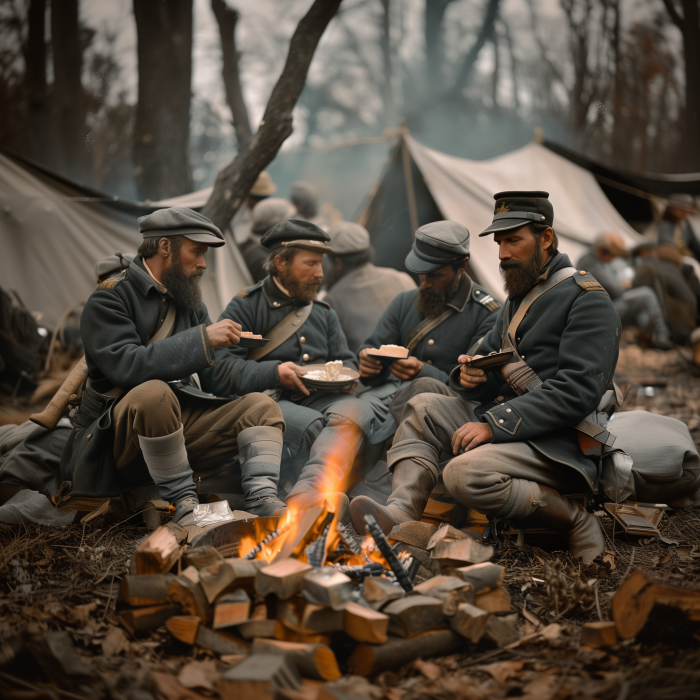How Has Memorial Day Influenced the Evolution of Cheese?
MAY 17, 2024

Memorial Day, originally called Decoration Day, was borne out of the Civil War, a conflict that had profound effects across all sectors, including the dairy and cheese industries. Prior to the war, cheese-making in America was largely a household affair, with families producing cheese primarily for personal consumption. However, the demands of wartime and the movement of troops necessitated greater production and standardization. Thus, the war inadvertently spurred the development of industrial cheese production. One of the earliest examples of this wartime innovation was the introduction of the 'Hoop Cheese,' a simple yet essential type of cheese that could be easily produced, transported, and stored. This type of cheese became a staple food not only for soldiers but also for civilians who faced disruptions in their daily lives due to the war.
Post Civil War, we see a transformative period in dairy science, significantly influenced by the need for more standardized and larger-scale cheese production. The Gilded Age, following shortly after, was a time when America saw advancements in the mechanization of dairy farms and the popularization of cheese varieties that are still beloved today. This era also witnessed the rise of cheese factories, a departure from the artisanal methods of yesteryears. Factories enabled the mass production of cheeses like Cheddar and Colby, named after their towns of origin, which began to dominate the American palate.
As we move into the 20th century, World War I and World War II further shaped the dairy industry. The exigencies of war once again underscored the importance of efficient food production. During World War I, American dairy farmers ramped up production to supply cheese to both soldiers and allied nations. This era also saw the introduction of processed cheese, championed by the Kraft Brothers, who patented a method for pasteurizing cheese to extend its shelf life. The invention of processed cheese became a battlefield staple, earning its place as a significant wartime culinary innovation.
World War II brought about stricter rationing and a renewed focus on nutrition. The U.S government, recognizing cheese as a vital source of protein and calcium, included it in military rations. This period also saw the rise of powdered milk cheese, a product born out of necessity but which also demonstrated the remarkable adaptability of dairy science in response to global demands.
Post World War II witnessed an interesting transition as America moved into the modern industrial age. The arrival of the television era and the simultaneous boom in the fast-food industry heralded new cheese-based culinary trends. Think of the quintessential American cheeseburger, which owes its ubiquity in part to these societal shifts. With Memorial Day barbecues as popular as ever, the tradition of enjoying a cheese-laden burger becomes not just a culinary act but a nod to the historical evolution of cheese consumption in America.
Even as we stand in the 21st century, contemporary cheese makers and dairy scientists continue to innovate, drawing inspiration from historical methodologies while also harnessing modern technology. The burgeoning interest in artisanal and farmstead cheeses reflects a return to tradition even as we forge ahead with new creations.
This Memorial Day, as we gather for barbecues and picnics, let's take a moment to appreciate the profound influence historical events have had on the humble yet versatile world of cheese. From the battlefield staples of Hoop Cheese to the modern, diverse cheese varieties that grace our tables today, each bite is a testament to the resilience and ingenuity that has characterized America's dairy history.
More in History
October 29, 2024
How has Halloween Influenced Cheese Throughout History?
June 03, 2024
What Makes Florette Cheese a Modern Culinary Marvel?
May 20, 2024
How Did Smoked Gouda Cheese Become a Culinary Staple?
May 17, 2024
How Has Memorial Day Influenced the Evolution of Cheese?
March 09, 2024
Did St. Patrick's Day Traditionally Feature Green Cheese?
March 07, 2024
How Easter Traditions Shaped Cheese-Making History
February 29, 2024
Discovering the Essence of Smoked Gouda: A Journey Through Time
February 16, 2024
How Florette Reflects the Evolution of Cheese Making